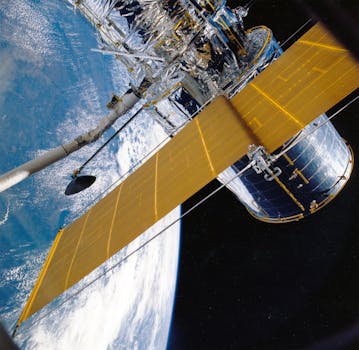Orbiting Innovations: Key Updates in Satellite Telecommunications Technology
The satellite telecommunications industry has witnessed significant advancements in recent years, with innovations in satellite design, launch technology, and communication protocols. This article explores the key updates in satellite telecommunications technology, including the development of low-earth orbit satellites, advanced propulsion systems, and enhanced communication protocols.

Orbiting Innovations: Key Updates in Satellite Telecommunications Technology
The satellite telecommunications industry has witnessed significant advancements in recent years, with innovations in satellite design, launch technology, and communication protocols. The development of low-earth orbit satellites, advanced propulsion systems, and enhanced communication protocols has transformed the way we communicate and access information. In this article, we will delve into the key updates in satellite telecommunications technology and explore the impact of these innovations on the industry.
One of the most significant advancements in satellite telecommunications technology is the development of low-earth orbit (LEO) satellites. LEO satellites are designed to operate at an altitude of around 160 to 2,000 kilometers, which is much lower than the traditional geostationary orbit (GEO) satellites that operate at an altitude of around 36,000 kilometers. LEO satellites have several advantages over GEO satellites, including lower latency, higher bandwidth, and improved communication quality. Companies such as SpaceX, OneWeb, and Amazon’s Kuiper Systems are leading the charge in the development of LEO satellites, with plans to launch thousands of satellites in the coming years.
Another significant innovation in satellite telecommunications technology is the development of advanced propulsion systems. Traditional satellite propulsion systems rely on chemical propulsion, which is expensive and inefficient. However, new propulsion systems such as electric propulsion and advanced ion engines are being developed, which offer higher efficiency and longer mission durations. These advanced propulsion systems will enable satellites to operate for longer periods, reducing the need for frequent replacements and minimizing the risk of satellite collisions.
In addition to the development of LEO satellites and advanced propulsion systems, there have been significant advancements in communication protocols. The development of new communication protocols such as 5G and quantum communication has enabled faster and more secure communication. These protocols have the potential to revolutionize the way we communicate, enabling real-time communication and data transfer. Furthermore, the development of advanced antennas and transceivers has improved the communication quality and reduced the size and weight of satellite communication equipment.
The impact of these innovations on the satellite telecommunications industry has been significant. The development of LEO satellites has enabled the provision of high-speed internet services to remote and underserved communities. Companies such as SpaceX and OneWeb are planning to offer internet services with speeds of up to 1 Gbps, which is comparable to fiber-optic broadband. The development of advanced propulsion systems has reduced the cost of satellite launches and enabled the deployment of more satellites. This has led to an increase in the number of satellite launches, with a record number of launches in 2020.
Despite the significant advancements in satellite telecommunications technology, there are still several challenges that need to be addressed. One of the major challenges is the risk of satellite collisions, which can result in significant damage to satellites and create debris in orbit. The development of advanced propulsion systems and more efficient satellite designs can help mitigate this risk. Another challenge is the issue of spectrum allocation, which is essential for satellite communication. The development of new communication protocols and advanced antennas has enabled more efficient use of spectrum, but there is still a need for more spectrum allocation to support the growing demand for satellite communication.
In conclusion, the satellite telecommunications industry has witnessed significant advancements in recent years, with innovations in satellite design, launch technology, and communication protocols. The development of LEO satellites, advanced propulsion systems, and enhanced communication protocols has transformed the way we communicate and access information. As the industry continues to evolve, we can expect to see even more innovative solutions to the challenges facing the industry.





